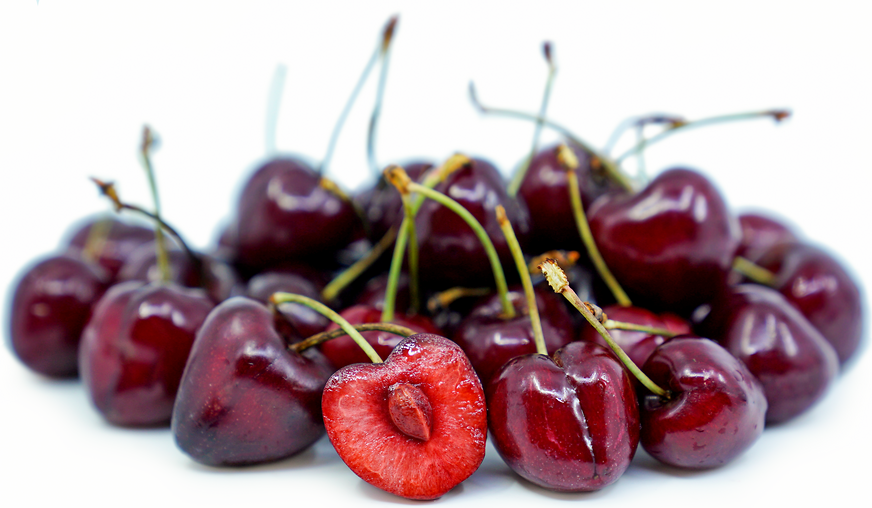


Lapins Cherries
Estimated Inventory, lb : 0
Description/Taste
Lapins cherries are a large varietal, averaging 2 to 4 centimeters in diameter, and have a cordate, round, to sometimes conical shape attached to a slender and fibrous, green-brown stem. The fruit’s skin is glossy, taut, and thin, showcasing vibrant ruby to crimson hues. Underneath the surface, the light red flesh is dense, semi-firm, aqueous, and plump, softening with maturity. The flesh also encases a central tan pit that does not adhere and is easily removed. Lapins cherries have a succulent consistency with low acidity when ripe, containing a mild, sweet, and fruity flavor. In addition to the fruits, the cherry trees also bear evergreen foliage and small white or pink blossoms in the late spring through early summer.
Seasons/Availability
Lapins cherries are available in late spring through early summer.
Current Facts
Lapins cherries, botanically classified as Prunus avium, are a hybrid sweet cherry belonging to the Rosaceae family. The mid to late summer variety grows on large trees that can reach up to 12 meters in height and was developed in British Columbia as a modern cultivar, similar to the popular bing cherry, but with improved characteristics. Lapins cherries are famous for their self-fertile nature, not requiring other cherry trees nearby for pollination to produce fruits. The tree is also highly productive, resilient to some disease, and the fruits are resistant to splitting. The variety became widespread after its release to commercial markets in the 1980s and eventually earned the prestigious Award of Garden of Merit in England. Despite their popularity, Lapins cherries were susceptible to pitting in transport, and the dense clusters of fruits were time-consuming to harvest off the trees, rendering them unfavorable for extended cultivation. In the present day, Lapins cherries are a valued home garden cultivar and are considered an ornamental addition to landscapes. The trees produce fragrant white or pink blooms in the late spring, sweet fruits in the summer, and colorful foliage in the fall.
Nutritional Value
Lapins cherries are a source of potassium to balance fluid levels within the body, calcium to strengthen bones and teeth, and vitamins A and C to boost the immune system, increase collagen production within the skin, and maintain healthy organ functioning. The fruits also contain anthocyanins, pigments found in the skin and flesh that give the fruit their dark purple-red coloring. These pigments have antioxidant-like properties to reduce inflammation and protect the cells against free-radical damage.
Applications
Lapins cherries have a mild, sweet flavor well suited for both fresh and cooked preparations. The fruits are similar in taste to bing cherries can be used as a substitute for the variety in recipes. Lapins cherries can be consumed straight, out of hand, or they can be juiced for cocktails, fruit punches, lemonade, or sparkling beverages. The cherries can also be tossed into green salads, stirred into fruit salads, mixed into rainbow vegetable bowls, or chopped into salsa. In addition to fresh preparations, Lapins cherries can be used as filling for tarts, doughnuts, cakes, and other pastries, cooked into sauces for savory meat-based dishes, infused into syrups, oils, and vinaigrettes, or baked into bread, scones, and muffins. The cherries can also be simmered into preserves or used to flavor liqueurs such as cherry brandy. Lapins cherries pair well with nuts such as almonds, pine nuts, pecans, and hazelnuts, meats including pork, poultry, duck, and fish, vanilla, caramel, dark chocolate, honey, and herbs such as basil, thyme, and mint. Whole, unwashed Lapins cherries will keep up to one week when stored between paper towels with good air circulation in the coldest part of the refrigerator. The fruits can also be canned or frozen for extended use.
Ethnic/Cultural Info
Lapins cherries were named after Dr. Charles Lapins, a famous Latvian horticulturist. Lapins is also known as Karlis O. Lapins, a name formerly used by the breeder in Latvia before changing it in British Columbia. Lapins studied agronomy in Latvia and later moved to British Columbia to give his family a better life. He first became a laborer for the Summerland Research Center, where he was tasked with correctly identifying mislabeled fruit trees. Lapins eventually went on to earn his master’s and doctorate degrees and returned to the Summerland Research Center as a breeder to create new cherry varieties. Lapins cherries are one of Dr. Charles Lapins’ most famous developments, and the fruits were released for commercial cultivation in the early 1980s. One unusual fact behind the name of the variety is that most cherry varieties developed at the Summerland Research Center during the 1980s were officially given names beginning with the letter “S.” Since Lapins cherries were considered valuable for their unique self-pollinating nature, the research center approved the variety to be named after Dr. Charles Lapins in honor of his work. Dr. Charles Lapins also developed the variety known as sunburst around the same time as the creation of Lapins cherries.
Geography/History
Lapins cherries were developed by Dr. Charles Lapins of the Summerland Research Center in British Columbia in the early 1970s. The hybrid variety is a cross between stella and van cherries and was selected for its productivity, flavor, and self-pollinating nature. Lapins cherries were released to markets in 1983 and quickly became a favored home garden and commercial cultivar in British Columbia and the United States in the 1980s and early 2000s. The productive variety was primarily grown for fresh eating and was one of the top cultivars cultivated in the Dalles region of Oregon in 2005. Over time, the variety eventually fell out of favor due to the popularity of other commercial varieties and inconsistent shipping quality. Today Lapins cherries are primarily grown by cherry enthusiasts in home gardens and specialty orchards in Canada, the United States, and the United Kingdom. When in season, the cherries are sold fresh through farmer’s markets and select distributors.
Recipe Ideas
Recipes that include Lapins Cherries. One
Podcast




